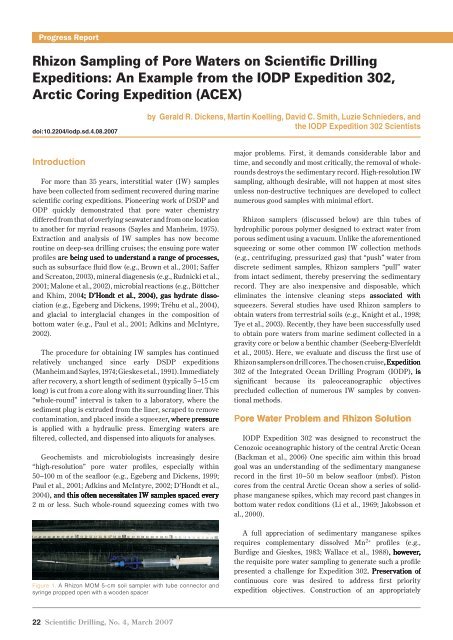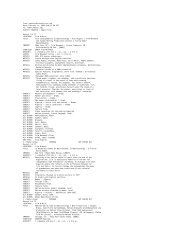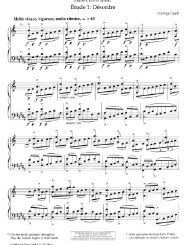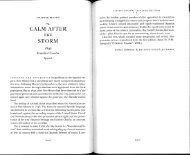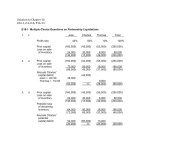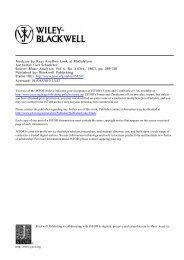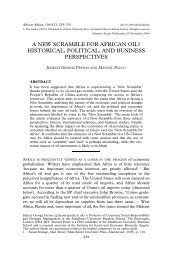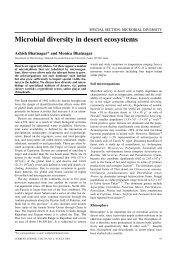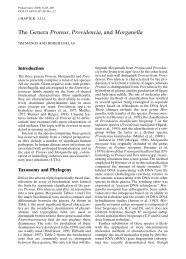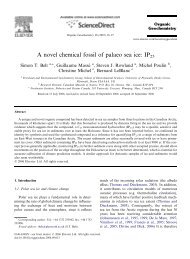Dickens et al 2007
Dickens et al 2007
Dickens et al 2007
Create successful ePaper yourself
Turn your PDF publications into a flip-book with our unique Google optimized e-Paper software.
Progress Report<br />
Rhizon Sampling of Pore Waters on Scientific Drilling<br />
Expeditions: An Example from the IODP Expedition 302,<br />
Arctic Coring Expedition (ACEX)<br />
�����������������������������<br />
������������<br />
For more than 35 years, interstiti<strong>al</strong> water (IW) samples<br />
have been collected from sediment recovered during marine<br />
scientific coring expeditions. Pioneering work of DSDP and<br />
ODP quickly demonstrated that pore water chemistry<br />
differed from that of overlying seawater and from one location<br />
to another for myriad reasons (Sayles and Manheim, 1975).<br />
Extraction and an<strong>al</strong>ysis of IW samples has now become<br />
routine on deep-sea drilling cruises; the ensuing pore water<br />
profiles are being used to understand a range of of processes,<br />
such as subsurface fluid flow (e.g., Brown <strong>et</strong> <strong>al</strong>., 2001; Saffer<br />
and Screaton, 2003), miner<strong>al</strong> diagenesis (e.g., Rudnicki <strong>et</strong> <strong>al</strong>.,<br />
2001; M<strong>al</strong>one <strong>et</strong> <strong>al</strong>., 2002), microbi<strong>al</strong> reactions (e.g., Böttcher<br />
and Khim, 2004; 4; ; D’Hondt <strong>et</strong> <strong>al</strong>., 2004), gas hydrate disso- dissociation<br />
(e.g., Egeberg and <strong>Dickens</strong>, 1999; Tréhu <strong>et</strong> <strong>al</strong>., 2004),<br />
and glaci<strong>al</strong> to interglaci<strong>al</strong> changes in the composition of<br />
bottom water (e.g., Paul <strong>et</strong> <strong>al</strong>., 2001; Adkins and McIntyre,<br />
2002).<br />
The procedure for obtaining IW samples has continued<br />
relatively unchanged since early DSDP expeditions<br />
(Manheim and Sayles, 1974; Gieskes <strong>et</strong> <strong>al</strong>., 1991). Immediately<br />
after recovery, a short length of sediment (typic<strong>al</strong>ly 5–15 cm<br />
long) is cut from a core <strong>al</strong>ong with its surrounding liner. This<br />
“whole-round” interv<strong>al</strong> is taken to a laboratory, where the<br />
sediment plug is extruded from the liner, scraped to remove<br />
contamination, and placed inside a squeezer, , where pressure ressure<br />
is applied with a hydraulic press. Emerging waters are<br />
filtered, collected, and dispensed into <strong>al</strong>iquots for an<strong>al</strong>yses.<br />
Geochemists and microbiologists increasingly desire<br />
“high-resolution” pore water profiles, especi<strong>al</strong>ly within<br />
50–100 m of the seafloor (e.g., Egeberg and <strong>Dickens</strong>, 1999;<br />
Paul <strong>et</strong> <strong>al</strong>., 2001; Adkins and McIntyre, 2002; D’Hondt <strong>et</strong> <strong>al</strong>.,<br />
2004), , and this his often often necessitates necessitates IW IW samples samples spaced spaced every<br />
every<br />
2 m or less. Such whole-round squeezing comes with two<br />
Figure 1. A Rhizon MOM 5-cm soil sampler with tube connector and<br />
syringe propped open with a wooden spacer<br />
����Scientific Drilling, No. 4, March <strong>2007</strong><br />
������������������������������������������������������������������������������<br />
����������������������������������<br />
major problems. First, it demands considerable labor and<br />
time, and secondly and most critic<strong>al</strong>ly, the remov<strong>al</strong> of wholerounds<br />
destroys the sedimentary record. High-resolution IW<br />
sampling, <strong>al</strong>though desirable, will not happen at most sites<br />
unless non-destructive techniques are developed to collect<br />
numerous good samples with minim<strong>al</strong> effort.<br />
Rhizon samplers (discussed below) are thin tubes of<br />
hydrophilic porous polymer designed to extract water from<br />
porous sediment using a vacuum. Unlike the aforementioned<br />
squeezing or some other common IW collection m<strong>et</strong>hods<br />
(e.g., centrifuging, pressurized gas) that “push” water from<br />
discr<strong>et</strong>e sediment samples, Rhizon samplers “pull” water<br />
from intact sediment, thereby preserving the sedimentary<br />
record. They are <strong>al</strong>so inexpensive and disposable, which<br />
eliminates the intensive cleaning steps associated with<br />
squeezers. Sever<strong>al</strong> studies have used Rhizon samplers to<br />
obtain waters from terrestri<strong>al</strong> soils (e.g., Knight <strong>et</strong> <strong>al</strong>., 1998;<br />
Tye <strong>et</strong> <strong>al</strong>., 2003). Recently, they have been successfully used<br />
to obtain pore waters from marine sediment collected in a<br />
gravity core or below a benthic chamber (Seeberg-Elverfeldt<br />
<strong>et</strong> <strong>al</strong>., 2005). Here, we ev<strong>al</strong>uate and discuss the first use of<br />
Rhizon samplers on drill cores. The chosen cruise,Expedition<br />
, Expedition<br />
302 of the Integrated Ocean Drilling Program (IODP), , is<br />
significant because its p<strong>al</strong>eoceanographic objectives<br />
precluded collection of numerous IW samples by convention<strong>al</strong><br />
m<strong>et</strong>hods.<br />
���� �������������������������������������<br />
����� ������� ��� ������ ��������<br />
IODP Expedition 302 was designed to reconstruct the<br />
Cenozoic oceanographic history of the centr<strong>al</strong> Arctic Ocean<br />
(Backman <strong>et</strong> <strong>al</strong>., 2006) One specific aim within this broad<br />
go<strong>al</strong> was an understanding of the sedimentary manganese<br />
record in the first 10–50 m below seafloor (mbsf). Piston<br />
cores from the centr<strong>al</strong> Arctic Ocean show a series of solidphase<br />
manganese spikes, which may record past changes in<br />
bottom water redox conditions (Li <strong>et</strong> <strong>al</strong>., 1969; Jakobsson <strong>et</strong><br />
<strong>al</strong>., 2000).<br />
A full appreciation of sedimentary manganese spikes<br />
requires complementary dissolved Mn2+ profiles (e.g.,<br />
Burdige and Gieskes, 1983; W<strong>al</strong>lace <strong>et</strong> <strong>al</strong>., 1988), , however,<br />
however, owever,<br />
the requisite pore water sampling to generate such a profile<br />
presented a ch<strong>al</strong>lenge for Expedition 302. . Preservation of<br />
continuous core was desired to address first priority<br />
expedition objectives. Construction of an appropriately
d<strong>et</strong>ailed dissolved Mn 2+ profile in sh<strong>al</strong>low sediment was<br />
therefore incompatible with Expedition 302 operations using<br />
tradition<strong>al</strong> means for collecting IW samples.<br />
Rhizon samplers present an unconvention<strong>al</strong> m<strong>et</strong>hod to<br />
collect IW samples from drill cores. In gener<strong>al</strong>, a Rhizon<br />
sampler consists of four parts (Seeberg-Elverfeldt <strong>et</strong> <strong>al</strong>.,<br />
2005): (1) a thin tube comprised of hydrophilic polymer,<br />
(2) a wire to support the tube, (3) a flexible hose to pass water<br />
from the tube, and (4) a connector. The porous tube is<br />
inserted into the sediment, and an evacuated container is<br />
attached to the connector. Pore water then passes from<br />
sediment through the porous tube and flexible hose into the<br />
collection chamber. Given a sufficiently sm<strong>al</strong>l tube pore size<br />
(0.1 µm), the Rhizon sampler <strong>al</strong>so serves as a filter, removing<br />
microbi<strong>al</strong> and colloid<strong>al</strong> contamination (Knight <strong>et</strong> <strong>al</strong>., 1998).<br />
For Expedition 302, we selected Rhizon MOM 5 cm soil<br />
samplers (Fig. 1). These have an outer diam<strong>et</strong>er of 2.4 mm, a<br />
length of 5 cm, a minimum pore size of 0.1 µm, a nylon<br />
supporting wire, and a PVC hose with a fem<strong>al</strong>e luer-lock uer-lock lock ock<br />
connector. They were the same as those used by Seeberg-<br />
Elverfeldt <strong>et</strong> <strong>al</strong>. (2005).<br />
Rhizon samplers collect interstiti<strong>al</strong> water most efficiently<br />
when their pores are saturated d with water prior to insertion.<br />
For or Expedition 302, porous tubes were submerged in a<br />
beaker of deionized water for at least 30 minutes before use.<br />
Each Rhizon nomin<strong>al</strong>ly contained 0.5 mL of of deionized deionized water<br />
water<br />
before IW sampling.<br />
��������������������������<br />
IODP Expedition 302 drilled five holes at four sites on the<br />
Lomonosov Ridge at ~88.5°N latitude, 136–140°E longitude,<br />
and in 1206–1288 1206–1288 m m water water depth depth (Backman (Backman <strong>et</strong> <strong>al</strong>., 2006). The<br />
five holes (M0002A, M0003A, and M0004A–C) have been<br />
grouped tog<strong>et</strong>her as a single drill site because they are<br />
proxim<strong>al</strong>, and because seismic reflection profiles show the<br />
same basic stratigraphy at each hole (Backman <strong>et</strong> <strong>al</strong>., 2006).<br />
Collectively, cores (~4.5 m in length) recovered recovered at at this this site<br />
site<br />
span a 428-m-thick -m-thick m-thick Campanian to Recent sedimentary<br />
sequence with sever<strong>al</strong> hiatuses. In this paper, we restrict<br />
discussion to the upper 50 mbsf because this is where we<br />
employed the Rhizon samplers. Sediment in this interv<strong>al</strong><br />
comprises soft, silty clay of Latest Pliocene to Recent age<br />
(Backman <strong>et</strong> <strong>al</strong>., 2006).<br />
Cores were passed down a Geotek logger immediately<br />
after recovery to establish basic physic<strong>al</strong> properties (sonic<br />
velocity, magn<strong>et</strong>ic susceptibility, , gamma attenuation and<br />
resistivity). Once initi<strong>al</strong>ly logged, IW samples were obtained<br />
by two m<strong>et</strong>hods: (1) cutting of whole-round interv<strong>al</strong>s and<br />
squeezing, and (2) Rhizon sampling of intact cores. Cores<br />
were logged again after sever<strong>al</strong> hours.<br />
Figure 2. Four Rhizon samplers collecting water under vacuum from a<br />
~10-cm interv<strong>al</strong> of a sh<strong>al</strong>low core.<br />
Whole-round interv<strong>al</strong>s of approximately 5–10 cm length<br />
were taken every third or fourth core. The over<strong>al</strong>l procedure<br />
(Backman <strong>et</strong> <strong>al</strong>., 2006) was similar to standard IODP<br />
protocol, with one notable exception. Because samples were<br />
taken after logging, there was a 30 to 40 minute delay in<br />
processing. However, this time lag probably did not modify<br />
pore water chemistry (at least relative to IW collection on<br />
previous expeditions) because temperatures of the sh<strong>al</strong>low<br />
water column and ship deck were very low (
Progress Report<br />
was d<strong>et</strong>ermined on dilutions of 5-mL -mL mL <strong>al</strong>iquots treated with<br />
ultra-pure concentrated HNO3 in the Department of<br />
Geosciences, University of Bremen, using Inductively<br />
Coupled Plasma Optic<strong>al</strong> Emission Spectrom<strong>et</strong>ry (ICP-OES).<br />
����������������������<br />
Repeated tests showed that deionized water flowss through<br />
Rhizons at >10 mL h -1 . This rate slowed considerably to<br />
0.3–3.0 mL hr -1 when Rhizons were placed into sediment.<br />
Moreover, there was a quasi-exponenti<strong>al</strong> decay in flow with<br />
core depth (Fig. 3), which probably relates to physic<strong>al</strong><br />
properties (e.g., decreasing porosity and permeability).<br />
Water did not flow appreciably from cores at >50 mbsf;<br />
however, Rhizon samples from
deep sediments of the Southwest Pacific (ODP Leg 181,<br />
Sites 1119-1125): Evidence vidence from stable sulfur isotope<br />
fractionation and pore water modeling. Mar. . Geol., Geol.<br />
205:<br />
249–260.<br />
Borowski, W.S., Paull, C.K., and Ussler, W., 1999. Glob<strong>al</strong> and loc<strong>al</strong><br />
variations of interstiti<strong>al</strong> sulfate gradients in deep-water,<br />
continent<strong>al</strong> margin sediments: Sensitivity to underlying<br />
m<strong>et</strong>hane and gas hydrates. Mar. Geol., 159:131–154.<br />
Brown, K.M., Saffer, D.M., and Bekins, B.A., 2001. Smectite<br />
diagenesis, pore-water freshening, and fluid flow at the toe<br />
of the Nankai wedge. Earth Plan<strong>et</strong>. Sci. L<strong>et</strong>t., 194:97–109.<br />
Burdige, D.J., and Gieskes, J.M., 1983. . A pore water/solid phase<br />
diagen<strong>et</strong>ic model for manganese in marine sediments.<br />
Amer. . J. Sci., Sci<br />
283: 29–47.<br />
D’Hondt, S., Jørgensen, B.B., Miller, D.J., Batzke, A., Blake, R., Cragg,<br />
B.A., Cypionka, H., <strong>Dickens</strong>, G.R., Ferdelman, T., Hinrichs,<br />
K-U., Holm, N.G., Mitterer, R., Spivack, A., Wang, G.,<br />
Bekins, B., Engelen, B., Ford, K., G<strong>et</strong>temy, G., Rutherford,<br />
S.D., Sass, H., Skilbeck, C.G., Aiello, I.W., Guèrin, G., House,<br />
C.H., Inagaki, F., Meister, P., Naehr, T., Niitsuma, S., Parkes,<br />
R.J., Schippers, A., Smith, D.C., Teske, A., Wiegel, J., Padilla,<br />
C.N., and Acosta, J.L.S., 2004. Distributions of microbi<strong>al</strong><br />
activities in deep subseafloor sediments. Science, 30:<br />
2216–2221.<br />
Egeberg, P.K., and <strong>Dickens</strong>, G.R., 1999. Thermodynamic and pore<br />
water h<strong>al</strong>ogen constraints on gas hydrate distribution at<br />
ODP Site 997 (Blake Ridge). Chem. Geol., 153:53–79.<br />
Gieskes, J.M., Gamo, T., and Brumsack, H., 1991. Chemic<strong>al</strong> m<strong>et</strong>hods<br />
for interstiti<strong>al</strong> water an<strong>al</strong>ysis aboard JOIDES Resolution.<br />
ODP Tech. Note:15.<br />
Hagelberg, T.K., Pisias, N.G., Shackl<strong>et</strong>on, N.J., Mix, A.C, and Harris,<br />
S., 1995. Refinement of a high-resolution, continuous<br />
sedimentary section for studying equatori<strong>al</strong> Pacific Ocean<br />
p<strong>al</strong>eoceanography. Proc. ODP, Sci. Res., 138:31–46.<br />
H<strong>al</strong>l, P.O.J., and Aller, R.C., 1992. Rapid sm<strong>al</strong>l-volume flow injection<br />
an<strong>al</strong>ysis for CO2 and NH4 in marine sediments. Limnol.<br />
Oceanogr., 35: 1113–1115.<br />
Jakobsson, M., Lovlie, R., Al-Hanb<strong>al</strong>i, H., Arnold, E., Backman, J., and<br />
Morth, M., 2000. Manganese and color cycles in Arctic<br />
Ocean sediments constrain Pleistocene chronology. Geology,<br />
28:23–26.<br />
Knight, B.P., Chaudri, A.M., McGrath, S.P., and Giller, K.E., 1998.<br />
D<strong>et</strong>ermination of chemic<strong>al</strong> availability of cadmium and zinc<br />
in soils using inert soil moisture samplers. Environ. Pollut.,<br />
99: 293–298.<br />
Li, Y.-H., Bischoff, J., and Mathieu, G., 1969. Migration of manganese<br />
in Arctic Basin Sediment Earth Plan<strong>et</strong>. Sci. L<strong>et</strong>t., 7:<br />
265–270.<br />
M<strong>al</strong>one, M.J., Claypool, G., Martin, J.B., and <strong>Dickens</strong>, G.R., 2002.<br />
Variable m<strong>et</strong>hane fluxes in sh<strong>al</strong>low marine systems over<br />
geologic time: The composition and origin of pore waters<br />
and authigenic carbonates on the New Jersey shelf. Mar.<br />
Geol., 189:175–196.<br />
Manheim, F.T., and Sayles, F.L., 1974. Composition and origin of<br />
interstiti<strong>al</strong> waters of marine sediments, based on deep sea<br />
drill cores. In Goldberg, E.D. (Ed.), The Sea (Vol. 5): Marine<br />
Chemistry: The Sedimentary Cycle: New York (Wiley),<br />
527–568.<br />
Paul, H.A., Bernasconi, S.M., Schmid, D.W., and McKenzie, J.A.,<br />
2001. Oxygen isotopic composition of the Mediterranean<br />
Sea since the last glaci<strong>al</strong> maximum: Constraints onstraints from from pore<br />
pore<br />
water an<strong>al</strong>yses. Earth Plan<strong>et</strong>. Sci. L<strong>et</strong>t., 192:1–14.<br />
Rudnicki, M.D., Wilson, P.A., and Anderson, W.T., 2001. Numeric<strong>al</strong><br />
models of diagenesis, sediment properties, and pore fluid<br />
chemistry on a p<strong>al</strong>eoceanographic transect; Blake Nose,<br />
Ocean Drilling Program Leg 171B. P<strong>al</strong>eoceanogr., 16:<br />
563–575.<br />
Saffer, D.M., and Screaton, E.J., 2003. Fluid flow at the toe of<br />
convergent margins; interpr<strong>et</strong>ation of sharp pore-water<br />
geochemic<strong>al</strong> gradients. Earth Plan<strong>et</strong>. Sci. L<strong>et</strong>t., 213:<br />
261–270.<br />
Sayles, F.L., and Manheim, F.T., 1975. The interstiti<strong>al</strong> solutions and<br />
diagenesis in deeply buried marine sediments: Results esults from<br />
deep-sea drilling project. Geochim. Cosmochim. Acta, 39:<br />
103–127.<br />
Seeberg-Elverfeldt, J., Schlüter, M., Feseker, T., and Kölling, M.,<br />
2005. A Rhizon in situ sampler (RISS) for pore water<br />
sampling from aquatic sediments. Limnol. nol. . Oceanogr. M<strong>et</strong>h.,<br />
.,<br />
3: 361–371.<br />
Tréhu, A.M., , Bohrmann, G., Rack, F.R., Torres, M.E., Bangs, N.L.,<br />
Barr, S.R., Borowski, W.S., Claypool, G.E., Coll<strong>et</strong>t, T.S.,<br />
Delwiche, M.E., <strong>Dickens</strong>, G.R., Goldberg, D.S., Gràcia, E.,<br />
Guèrin, G., Holland, M., Johnson, J.E., Lee, Y-J., Liu, C-S.,<br />
Long, P.E., Milkov, A.V., Riedel, M., Schultheiss, P., Su, X.,<br />
Teichert, B., Tomaru, H., Vanneste, M., Watanabe, M., and<br />
Weinberger, J.L., 2004. Three-dimension<strong>al</strong> distribution of<br />
gas hydrate beneath southern Hydrate Ridge: Constraints onstraints<br />
from ODP Leg 204. Earth Plan<strong>et</strong>. Sci. L<strong>et</strong>t., 222:845–862.<br />
Tye, A.M., , Young, S.D., Crout, N.M., Zhang, H., Preston, S., Barbosa-<br />
Jefferson, V.L., Davison, W., McGrath, S.P., Paton, G.I.,<br />
Kilham, K., and Resende, L., 2003. Predicting the activity of<br />
Cd2+ and Zn2+ in soil pore water from the radio-labile m<strong>et</strong><strong>al</strong><br />
fraction. Geochim. Cosmochim. Acta, 67:375–385.<br />
W<strong>al</strong>lace, H.E., Thomson, J., Wilson, T.R.S., Weaver, P.P.E., Higgs,<br />
�������<br />
N.C., and Hydes, D.J., 1988. Active diagen<strong>et</strong>ic formation of<br />
m<strong>et</strong><strong>al</strong>-rich layers in NE Atlantic Sediments. Geochim.<br />
Cosmochim. Acta, 52:1557–1569.<br />
Ger<strong>al</strong>d R. <strong>Dickens</strong>, Department of Earth Sciences, Rice<br />
University, Houston, Texas exas 77005, U.S.A., .S.A., S.A., .A., A., ., , e-mail:<br />
e-mail:<br />
e-mail:<br />
e-mail:<br />
jerry@rice.edu<br />
Martin Kölling, Department of Geosciences, University of<br />
Bremen, 28359 Bremen, Germany.<br />
David C. Smith, Graduate School of Oceanography,<br />
University of Rhode Island, Narragans<strong>et</strong>t, R.I. .I. I. . 02882, 02882, U.S.A.<br />
U.S.A. .S.A. S.A. .A. A.<br />
Luzie Schnieders, Department of Geosciences, University<br />
of Bremen, 28359 Bremen, Germany.<br />
Scientific Drilling, No. 4, March <strong>2007</strong> ��


